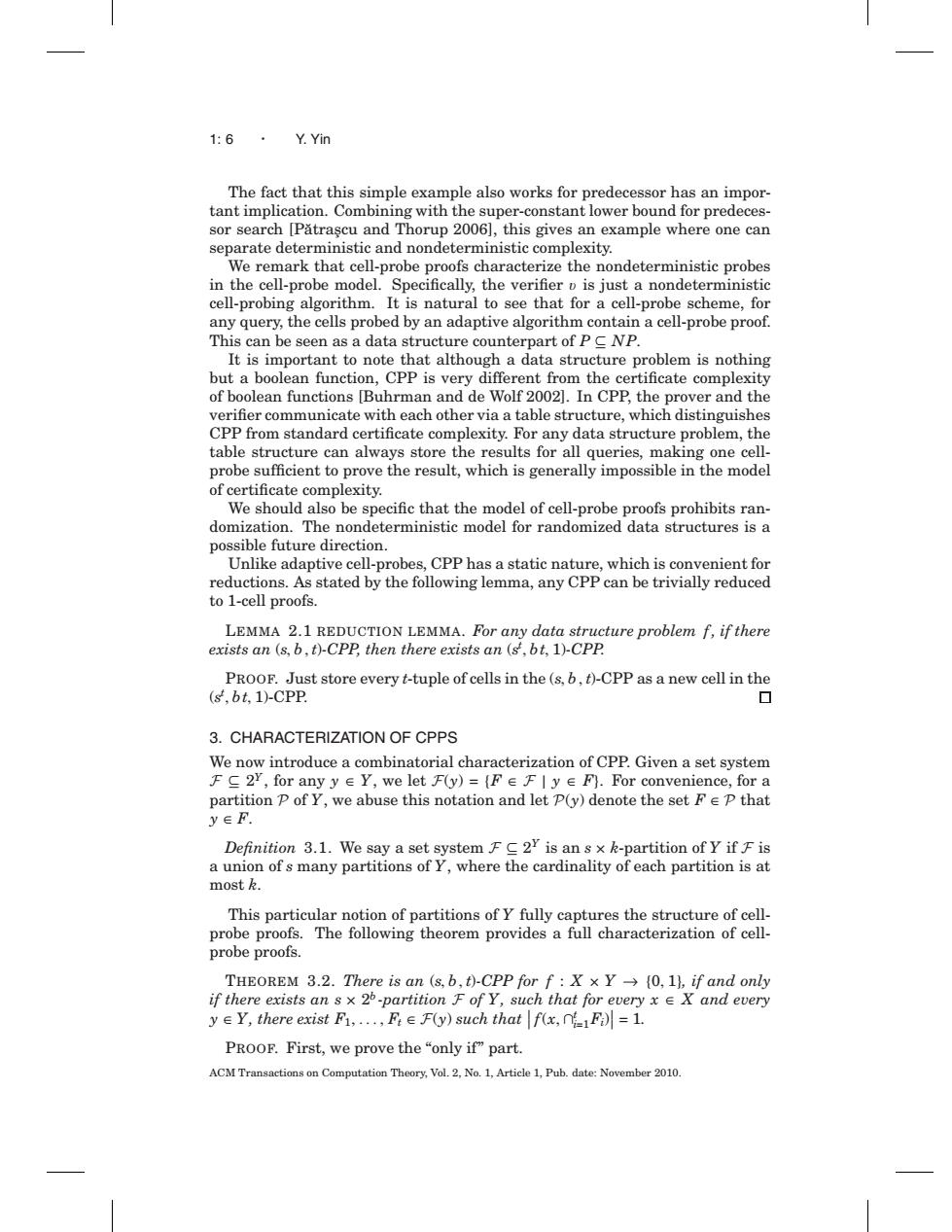正在加载图片...

1:6·Y.Yin The fact that this simple example also works for predecessor has an impor- tant implication.Combining with the super-constant lower bound for predeces- sor search [Patrascu and Thorup 2006],this gives an example where one can separate deterministic and nondeterministic complexity. We remark that cell-probe proofs characterize the nondeterministic probes in the cell-probe model.Specifically,the verifier o is just a nondeterministic cell-probing algorithm.It is natural to see that for a cell-probe scheme,for any query,the cells probed by an adaptive algorithm contain a cell-probe proof. This can be seen as a data structure counterpart of P NP. It is important to note that although a data structure problem is nothing but a boolean function,CPP is very different from the certificate complexity of boolean functions [Buhrman and de Wolf 2002].In CPP,the prover and the verifier communicate with each other via a table structure,which distinguishes CPP from standard certificate complexity.For any data structure problem,the table structure can always store the results for all queries,making one cell- probe sufficient to prove the result,which is generally impossible in the model of certificate complexity. We should also be specific that the model of cell-probe proofs prohibits ran- domization.The nondeterministic model for randomized data structures is a possible future direction. Unlike adaptive cell-probes,CPP has a static nature,which is convenient for reductions.As stated by the following lemma,any CPP can be trivially reduced to 1-cell proofs. LEMMA 2.1 REDUCTION LEMMA.For any data structure problem f,if there exists an (s,b,t)-CPP,then there exists an (st,bt,1)-CPP. PROOF.Just store every t-tuple of cells in the(s,b,t)-CPP as a new cell in the (sf,bt,1)-CPP. ▣ 3.CHARACTERIZATION OF CPPS We now introduce a combinatorial characterization of CPP.Given a set system FC2Y,for any yY,we let F(y)=(FEFIy e F).For convenience,for a partition P of y,we abuse this notation and let P(y)denote the set FeP that y∈F. Definition 3.1.We say a set system FC2Y is an s x k-partition of y if F is a union ofs many partitions of y,where the cardinality of each partition is at most k. This particular notion of partitions of y fully captures the structure of cell- probe proofs.The following theorem provides a full characterization of cell- probe proofs. THEOREM3.2.There is an(s,b,t)-CPP for f:X×Y→{0,1},if and only if there exists an s x 26-partition F of Y,such that for every x e X and every yeY,there exist F1,...,FeF(y)such that f(x,F)=1. PROOF.First,we prove the“only if”part. ACM Transactions on Computation Theory,Vol.2,No.1,Article 1,Pub.date:November 2010.1: 6 · Y. Yin The fact that this simple example also works for predecessor has an important implication. Combining with the super-constant lower bound for predecessor search [Patras ˘ ¸cu and Thorup 2006], this gives an example where one can separate deterministic and nondeterministic complexity. We remark that cell-probe proofs characterize the nondeterministic probes in the cell-probe model. Specifically, the verifier v is just a nondeterministic cell-probing algorithm. It is natural to see that for a cell-probe scheme, for any query, the cells probed by an adaptive algorithm contain a cell-probe proof. This can be seen as a data structure counterpart of P ⊆ NP. It is important to note that although a data structure problem is nothing but a boolean function, CPP is very different from the certificate complexity of boolean functions [Buhrman and de Wolf 2002]. In CPP, the prover and the verifier communicate with each other via a table structure, which distinguishes CPP from standard certificate complexity. For any data structure problem, the table structure can always store the results for all queries, making one cellprobe sufficient to prove the result, which is generally impossible in the model of certificate complexity. We should also be specific that the model of cell-probe proofs prohibits randomization. The nondeterministic model for randomized data structures is a possible future direction. Unlike adaptive cell-probes, CPP has a static nature, which is convenient for reductions. As stated by the following lemma, any CPP can be trivially reduced to 1-cell proofs. LEMMA 2.1 REDUCTION LEMMA. For any data structure problem f, if there exists an (s, b,t)-CPP, then there exists an (st , b t, 1)-CPP. PROOF. Just store every t-tuple of cells in the (s, b,t)-CPP as a new cell in the (st , b t, 1)-CPP. 3. CHARACTERIZATION OF CPPS We now introduce a combinatorial characterization of CPP. Given a set system F ⊆ 2Y , for any y ∈ Y, we let F(y) = {F ∈ F | y ∈ F}. For convenience, for a partition P of Y, we abuse this notation and let P(y) denote the set F ∈ P that y ∈ F. Definition 3.1. We say a set system F ⊆ 2Y is an s × k-partition of Y if F is a union of s many partitions of Y, where the cardinality of each partition is at most k. This particular notion of partitions of Y fully captures the structure of cellprobe proofs. The following theorem provides a full characterization of cellprobe proofs. THEOREM 3.2. There is an (s, b,t)-CPP for f : X × Y → {0, 1}, if and only if there exists an s × 2b -partition F of Y, such that for every x ∈ X and every y ∈ Y, there exist F1,..., Ft ∈ F(y) such that f(x,∩t i=1Fi) = 1. PROOF. First, we prove the “only if ” part. ACM Transactions on Computation Theory, Vol. 2, No. 1, Article 1, Pub. date: November 2010